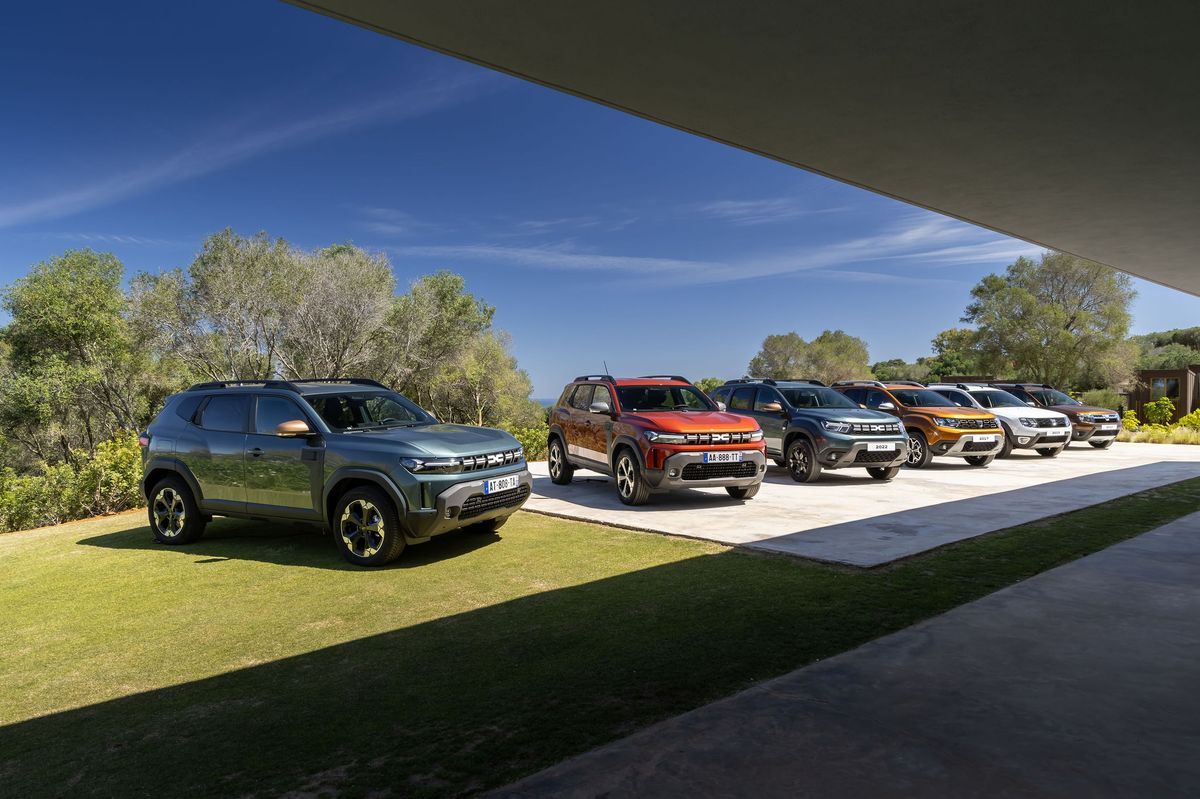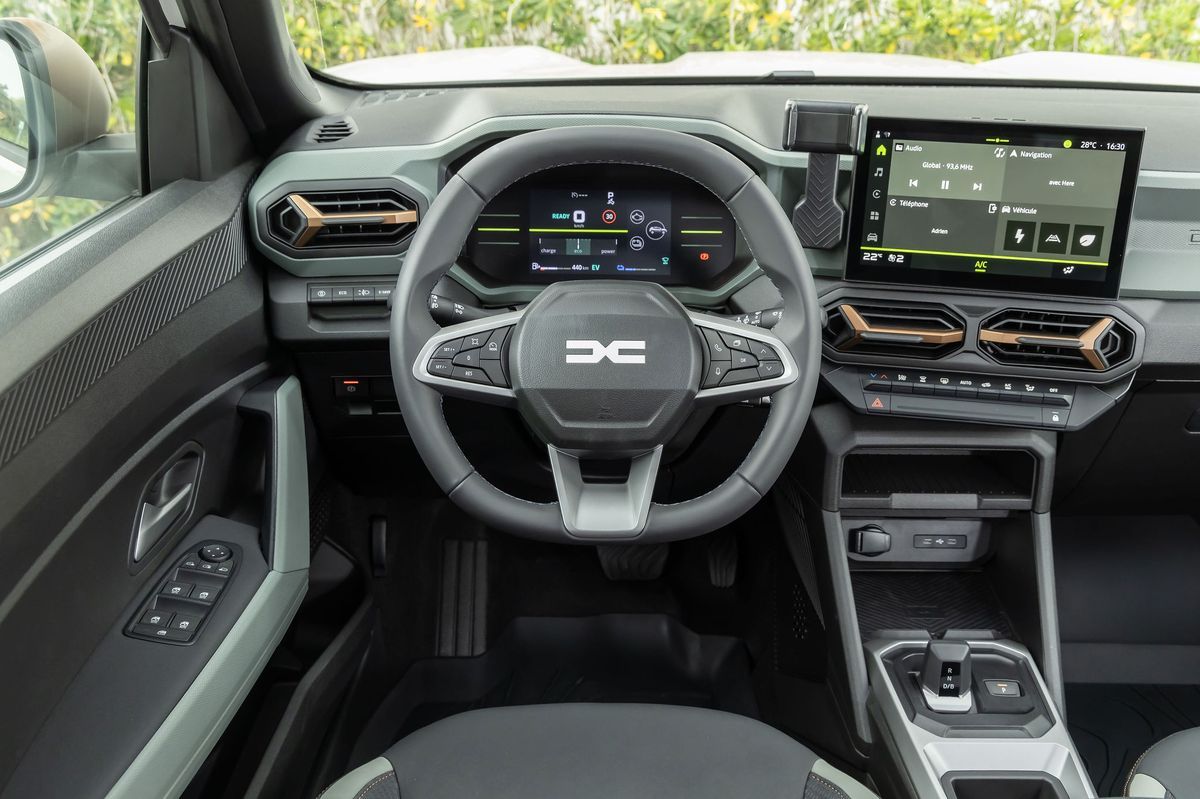The first generation Dacia Duster was launched in 2010 and fairly quickly built a reputation as an affordable and practical family SUV that is not afraid of the terrain. The next generation also carried on the same wave, which, however, had a more evolutionary effect. But the third generation is revolutionary.
The car still measures 4.34 meters in length, but is slightly lower (1.66 m) and slightly wider (1.81 m). The wheelbase is 2657 mm, or 2658 with all-wheel drive. Depending on the number of driven axles, the ground clearance also changes – a two-wheeler offers 209 mm, a four-wheeler 217 mm. Only the four-wheeler can then boast a multi-element rear axle, while the other engines have a torsion bar.
The fundamental change is the use of the new CMF-B platform, thanks to which the duster offers higher body stiffness (and thus better handling), lower noise and more interior space. The rear passengers thus have 30 mm more legroom, and the luggage compartment offers up to 517 liters or 1,696 liters when the rear seats are folded down.
The new Dacia Duster has a Czech price list, offers hybrid, four-wheel drive and LPG
AutoMoto
For the first time, the design is based on the brand’s new identity and was inspired by the Dacia Bigster concept. The Duster impresses with its sharply cut lines, looks modern and robust. There are distinctive plastic wraps, headlights with a characteristic signature or modern graphics of the brand, including the logo and mask filling. However, the shapes of the rear lights look unusually bold.
The cabin is nowhere near as boring as it was in the past. Although hard plastics still dominate, in addition to black, the designers have also brought several distinctive colors, such as green or copper, which pleasantly make the cabin special. Sharply cut shapes and an emphasis on robustness are also repeated in the cabin, but the rich technological equipment also impresses.
In front of the driver is a 7-inch digital instrument panel with relatively simple, but understandable and easy-to-read graphics. A 10.1″ touchscreen infotainment display emerges from the dashboard, which has a very simple and clear menu. Its running is more or less smooth, but when using the built-in navigation, you can feel small hiccups.
Photo: Dacia
The air conditioning still has its own control panel, but unfortunately only in the form of keys, similar to the Renault Austral. Temperature information and ventilation settings are on the display and the controls take some getting used to. However, the setting of the audio volume in the form of two keys on the upper edge of the infotainment is unfortunate. Fortunately, the driver still had a practical selector on the steering column.
Next to the display, there is also a practical holder for a mobile phone, attached via a special YouClip holder, which can also be found in the back of the center console or in the trunk. The solution is practical and original, but at least the phone holder freezes, which causes the phone to shake a lot in the holder.
Probably the smartest function in the cabin of the new Dacia Duster is the button to the left of the steering wheel, which can be used to easily turn off some or all of the annoying assistance systems. That is, including monitoring of driving in lanes and warning of the maximum permitted speed.

Photo: Dacia
Dacia Duster of all generations
First time with a hybrid
After landing in Malaga, we started the test drives behind the wheel of the hybrid model, which is the spiritual successor of the diesel engine. Unfortunately, we can no longer find it in the price list. The hybrid is the only one with an automatic transmission, but only drives the front wheels.
The hybrid system, which was supposed to appear in the Dacia Jogger model a year ago, does not need to be introduced at length. We already know it from the Renault Arkana and Clio models, where it works very well. And this is especially true when driving calmly, which also applies to the less aerodynamic Dacia Duster. which with the hybrid weighs almost 1.4 tons.
The basis of the system is an atmospheric four-cylinder gasoline engine with a volume of 1.6 liters, which is complemented by an electric motor and a reinforced starter-generator. Power transmission to the front wheels is handled by a multi-mode transmission with four gears for the combustion engine and two gears for the electric motor.
After sitting behind the wheel, we were pleasantly surprised by the front seats, which, although they are manually adjusted, got rid of the slight swaying, feel more comfortable and have reinforced lateral guidance. A lumbar support is then available depending on the equipment. The side windows have a smaller intergenerational impression and the glazing line is higher, but it is still decently visible from the cabin. The view through the upright hood with prominent moldings is reminiscent of iconic offroads.
We also automatically tested the rear seats, which offer enough space and comfort even for adult passengers. Getting in is comfortable, but the impression is somewhat spoiled by details such as the metal door frame with an exposed screw leading directly into the cabin. The trunk of the hybrid model offers a volume of only 430 liters, because the battery is under the plate.

Photo: Dacia
In terms of driving, the situation known from the Renault Arkana is repeated. If you don’t want much from a hybrid, it works very nicely, smoothly and relatively quietly. At lower speeds, thanks to the electric motor, it accelerates perfectly, it smoothly alternates between the combustion engine and the electric motor, it does not rev too much, and the consumption in the combined mode was around 5.3 l/100 km.
During dynamic driving, however, the engine loses its refinement, it often revs up unnecessarily (due to battery charging), and you mainly hear the smooth acceleration at higher speeds rather than actually feeling it. Despite the highest performance, it is more suitable for corsage, when it promises up to 80% of the time in electric mode when driving around town.
A very nice surprise turned out to be the chassis, which is tuned primarily for comfort. However, it did not lean too much even in briskly driven corners and seemed very stable. However, if you push too hard on the saw, you may be reminded of the character of an available family SUV by an unexpected swing or bounce.
Internal combustion three-cylinder
The basic liter three-cylinder, which burns both gasoline and LPG, was unfortunately missing on the first drives. Therefore, we switched from the hybrid to a more powerful three-cylinder 1200 with an output of 130 horsepower. The engine is connected to a 48V mild-hybrid system and exclusively sends power to either the front or, optionally, all four wheels via a six-speed manual transmission.

Photo: Dacia
A sleeping unit is also available for CZK 38,900.
The TCe 130 engine offers significantly more interesting dynamics, at least in terms of feel. From 2,000 rpm, the engine pulls beautifully and with the classic three-cylinder rasper, the SUV gets from 0 to 100 km/h in 9.9 seconds, which is, however, only 0.2 seconds better than the hybrid. With a 4×4 drive, you wait 11 seconds.
Working with the gear lever feels pleasant, but the clutch pedal has a very long stroke, which should supposedly help when driving off-road. But it complicates the subordination a bit. Also, the accelerator pedal could be slightly more sensitive and respond better to being pressed. However, the brakes worked solidly, thanks to the optional electronic disc parking brake on both axles.
The twelve-speedster offers sufficient vigor and sophistication, even on highways. At higher speeds, you can feel the increase in aerodynamic noise, but overall the noise reduction is at a decent level and does not even let the noise of rough Spanish asphalt into the cabin. Consumption in combined mode was around 6.5 l/100 km.
It won’t get lost in the field
The duster reliably sells its robust character even in the front-wheel drive version, in which we went to the nature park. Conquering steep climbs on gravel and dirt broken roads was not the least bit of a problem, yet we felt that an ATV would offer more freedom, confidence and more fun. Especially with the ESP system off, which only reactivates at a speed of 50 km/h.

Photo: Dacia
To test the all-wheel drive system, whose mechanical basis comes from the previous generation – but with improved components and more sophisticated electronics, we went to a specially prepared polygon. Here, Duster demonstrated the crossing of axles, side tilts of around 24 degrees, hill descent assistant with a fixed speed and hill start assistant.
A great addition is an infographic showing the distribution of the torque between the axles, the inclination of the car and, above all, footage from the cameras around the entire car. A view of the front wheels will make it easier to maneuver around obstacles, and the camera in the mask will help with exits. For completeness, let’s add that the car has a front approach angle of 31 °, a departure angle of 36 °, and the engine is protected by a sheet of steel.
The ride continues
Dacia Duster has undergone a major transformation, but it could hardly have turned out better. Although we would have liked a diesel engine or a combination of all-wheel drive and automatic transmission, except for a few minor details, the Duster has retained the character of a practical car that can keep up with the demands of an ordinary family and won’t get lost even in the off-road. Moreover, at prices that are still very affordable.
| Motorization of the new Dacia Duster | ||
|---|---|---|
| Engine | Transmission | Max. performance |
| Petrol | ||
| Eco-G 100 | 6 st. manual | 67 kW/74 kW (LPG) |
| TCe 130 | 6 st. manual | 96 kW |
| TCe 130 4×4 | 6 st. manual | 96 kW |
| Hybrid 140 | 4 st. automatic | 104 kW |
Purely electric Dacia Duster? The automaker has enough time for now
AutoMoto













